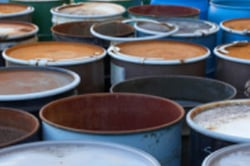Why It's Important to Read an SDS When Using a Material for the First Time
Occasionally, a plant manager will find themselves asking how to read an SDS in facing one or more of these scenarios:
- Plant workers are informed of a new chemical material to be used in the production process.
- A maintenance worker starts a new assignment with specific cleaning materials.
- A trial material is introduced to a process to improve its efficiency.
These cases have one thing in common: workers are exposed to new and potentially hazardous materials and will be using them for the first time. These types of changes introduce new risks and must be properly managed to avoid personal injury or any structural/mechanical damage. In these scenarios, it is key for workers to understand the implications of working with the unfamiliar material, and the best place to start is with its Safety Data Sheet (SDS).
As we’ve seen in our series on How to Understand SDSs, Safety Data Sheets are rich with information, which cover emergency situations as well as everyday situations.
So, what do you need to know when using a new chemical product? Where do you start with your SDS?
This article will answer these questions by outlining the most important sections to review prior to using a new material, and the essential information to remember while reviewing them. It’s also important to note that your employees should understand how to read an entire SDS and be familiar with every section of the SDS for any product they will be using – but this article will focus on
Staying Safe!
 For any new product, knowing how to protect yourself against physical or health effects should be one of your first goals. All SDSs are required to contain significant health and safety information specific to the accompanying material. When reviewing the SDS prior to using a product for the first time, Section 8: Exposure Controls and Personal Protection Equipment will help you determine how to stay safe while using the product.
For any new product, knowing how to protect yourself against physical or health effects should be one of your first goals. All SDSs are required to contain significant health and safety information specific to the accompanying material. When reviewing the SDS prior to using a product for the first time, Section 8: Exposure Controls and Personal Protection Equipment will help you determine how to stay safe while using the product.
SDS Section 8 This section will list the supplier’s recommended measures to limit exposure through personal protection equipment and technical controls. The permissible workplace exposure levels for the chemicals contained in the material are also listed for the relevant authorities (e.g. ACGIH, NIOSH, state and country specific limits). This information allows a worker to properly prepare for exposure to the material and its hazardous chemicals.
Handling the Material
In addition to describing equipment and acceptable exposure limits in Section 8, the SDS also includes the recommended guidelines for the safe handling of the material. In Section 7: Handling and Storage, the supplier details measures that will minimize the associated risks when safely working with hazardous materials.
These measures include descriptions of safe practices, requirements related to ventilation, and storage guidelines. By following these guidelines, a worker can proactively implement safety precautions when handling and storing hazardous materials, minimizing the risk of damage to their surroundings.
Is This the Correct Material?
The most immediate need, at least from the perspective of a plant safety manager, are contained in SDS Section 7 and SDS Section 8 – however, we believe that employees should also be given hands-on training in how to understand Section 9: Physical and Chemical Properties.
It is a good practice to review the identifying characteristics of the products before using it by consulting Section 9: Physical and Chemical Properties. While some of the information presented in this section can be overwhelmingly technical for employees without a chemistry background, it will help in identifying and confirming that the material being used is in fact the correct material.
Examples of important characteristics include appearance, chemical state, odor description, etc. If there are differences between the properties listed on the SDS and the characteristics of the material, it may indicate that the wrong material is being used, or that the material is no longer in a usable condition.
Employees can use this information to make sure that they are actually using the right chemical product – wearing the correct PPE for a process but using the entirely wrong chemical product puts your staff in danger and jeopardizes the quality of your end product.
What to Watch Out For
 Despite taking the best available precautionary and preventative measures, it is always possible for an incident or an accident to occur when handling and storing hazardous materials. For that reason, it’s important to know what potential dangers exist and their corresponding warning signs.
Despite taking the best available precautionary and preventative measures, it is always possible for an incident or an accident to occur when handling and storing hazardous materials. For that reason, it’s important to know what potential dangers exist and their corresponding warning signs.
For this, Section 2: Hazards Identification provides a description of the main hazards associated with a material and the applicable Precautionary Statements advising the material’s safe use and appropriate response to emergencies. This SDS section allows the worker to prepare for the material’s hazards and to recognize the warning signs. For example, a worker will pay closer attention to feelings of nausea or general discomfort when working with materials known to have acute health effects.
Additional information on what to look out for can be found in the Most Important Symptoms and Effects, Both Acute and Delayed category of Section 4: First-Aid Measures. Here the supplier provides detailed information on signs and symptoms arising from dangerous exposure levels of the material. A worker can use this information to assess if they, or one of their coworkers, may have been exposed to dangerous levels of the material and take appropriate action, whether it is to reduce exposure or start first-aid treatment. It is also useful for emergency responders and medical personnel when dealing with a chemical emergency situation on site.
Chemical Dangers
Another section of the SDS that will provide information relevant to the handling of the new product is Section 10: Stability and Reactivity. In this section, the supplier describes certain risks related to the reactivity of the material. This includes information on how susceptible a material is to chemical reactions, what other chemicals could react with this material and render it unusable, conditions susceptible to damaging the material or creating a hazardous situation, and any potential hazards arising from chemical reactions due to the decomposition of the material. A review of this section prior to using a new material allows the worker to assess potential risks arising from external conditions or nearby materials during the handling or storage of the material.
How to Eliminate Waste
 There are several rules and regulations governing the proper disposal of excess of used hazardous materials. As such, it is important to know how to dispose of hazardous materials prior to using them, so that the proper containment procedures may be used during the handling of the material. Then the waste can be handled efficiently without increasing exposure to dangerous levels of the hazardous waste. Specific information on the proper handling of a material in the waste phase of its use cycle can be found in SDS Section 13: Disposal Considerations. Any exception or rule regarding specific waste procedures or regulations to consider during elimination will be found in this section.
There are several rules and regulations governing the proper disposal of excess of used hazardous materials. As such, it is important to know how to dispose of hazardous materials prior to using them, so that the proper containment procedures may be used during the handling of the material. Then the waste can be handled efficiently without increasing exposure to dangerous levels of the hazardous waste. Specific information on the proper handling of a material in the waste phase of its use cycle can be found in SDS Section 13: Disposal Considerations. Any exception or rule regarding specific waste procedures or regulations to consider during elimination will be found in this section.
When working with a material for the first time, it is good practice to review these considerations and make sure the proper disposal procedures exist in the workplace to ensure the safety of coworkers and the community, as well as regulatory compliance.
A Final Word
It is certainly important to get SDS training on the contents of your entire SDS, yet some is more relevant to emergency responders, or primarily applies in very specific situations. When working with a material for the first time, the most important SDS sections to keep in mind are those that can affect your day-to-day use of the material, namely:
- Section 8: Exposure Controls and Personal Protection Equipment for information on how to protect yourself
- Section 7: Handling and Storage for details on how to safely handle and store the material
- Section 9: Physical and Chemical Properties to ensure you know some defining characteristics of the material
- Section 2: Hazards Identification and Section 4: First-Aid Measures for information on the hazards and warning signs of exposure to the material
- Section 10: Stability and Reactivity for additional hazards specific to the chemical nature of the material
- Section 13: Disposal Considerations for information on the proper handling of waste
Watch a Free SDS Compliance Webinar
Available now, ERA is offering a free SDS compliance webinar for Health & Safety managers and chemical specilaists. This on-demand webinar details what you need to know about Safety Data Sheets for OSHA compliance, as well as highlights about WHMIS (in Canada) and CLP.
In this 40 minute webinar, you'll learn:
- SDS Authoring Dos and Don'ts
- where to find chemical data for authoring your SDSs
- Differences between CLP, WHMIS, and OSHA regulations for chemical safety
Click the button below to access the free on-demand webinar.
This Blog was Co-Authored By:



March 14, 2018

Comments